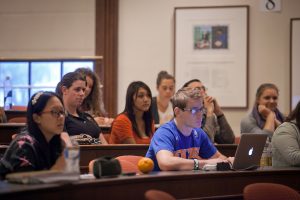Professors learn more effective teaching methods to ensure an inclusive student experience
It’s easy to see the value of a more diverse student body. People from a variety of backgrounds enrich the academic environment and bring different perspectives to campus.
An increase in diversity also challenges faculty to adopt effective teaching methods to match it.
 “We as educators must strive to learn what we can do to increase diversity awareness and take actions towards inclusivity in the classroom,” says Kim Case, professor of psychology at University of Houston.
“We as educators must strive to learn what we can do to increase diversity awareness and take actions towards inclusivity in the classroom,” says Kim Case, professor of psychology at University of Houston.
Case, a national expert on inclusive teaching methods, presented the keynote lecture last month at the College’s Applying Diversity and Inclusion across the Curriculum conference.
Hosted by the Center for the Integration of Teaching, Learning, and Scholarship, the conference brought together professors and administrators from the Lehigh Valley Association of Independent Colleges.
“Because I’m a math professor, I don’t have as much firsthand experience with working in this framework in my classes,” says Chawne Kimber, professor of math and conference organizer. “It is important to know the differing classroom atmospheres in various disciplines and to understand the struggles our faculty may face in those situations.”
Professors explored these issues through an active learning workshop. Some of the topics covered were helping students feel more comfortable in new situations, how to respond when classroom discussions become contentious, and how to incorporate more diversity content, readings, assignments, and critical thinking into course curriculum.
“We all carry unconscious biases, stereotypes, and assumptions that take a lifetime to continually try to unlearn,” says Case. “Therefore, we have to reflect on our own areas of privilege and how various intersections of identity and oppression are often invisible to us. If we can begin to make these issues visible for ourselves, we can then guide students as they learn about these issues.”
Biology professor Mike Butler believes that dealing with many of these issues doesn’t require a great deal of effort; a few thoughtful changes can make a classroom far more inclusive. An example that stuck out for him was better articulating the purpose of office hours.
“There are many students who are unaware that it’s OK to approach professors,” he says. “Some students have been around colleges before, or their parents have, and they’ve been told to take advantage of these resources. Others were never told this directly, and it puts them at a disadvantage. So, I’m trying to make office hours more transparent, and reiterating the invitation-like nature of them as well.”
There was a “syllabus challenge.” Professors examined every part of their printed syllabi to see if they are potentially exclusionary or offensive and discussed alternate ways to approach writing. Themes included intersectionality, the interconnected nature of social categorizations such as race, class, and gender that create discrimination or disadvantage.
“Intersectionality is a concept and can be written directly into a class’ learning outcomes on the syllabus,” says Brett Hendrickson, assistant professor of religious studies. “If it’s in the outcomes, it helps both students and instructor to work toward incorporating intersectional subject matter and specific assignments into the course.”
The professors also took an inventory of their personal privileges, such as those associated with gender, race, class, and socioeconomics, and examined how they may help or harm a classroom discussion. Mallory SoRelle, assistant professor of government and law, is interested in finding ways to navigate these potential blind spots.
“A point of emphasis was the need to pair discussions of inequality with the sometimes more uncomfortable subject of privilege,” she says. “We all thought through this dynamic by exploring some of our own privileged and disadvantaged identity characteristics and how those affect our interactions with students.”
Hendrickson learned one way to broach this subject, which involves posting four quotes or statements that have to do with the class session in each corner of the room. Students then go around to read the quotes, pick their favorite, and explain why they chose their statement.
“Dr. Case spoke about the need to move beyond the modality of diversity education where minorities or disadvantaged groups are merely tacked onto existing classes, but to really rethink our overall approach to classroom dynamics,” says Hendrickson.
 “We as educators must strive to learn what we can do to increase diversity awareness and take actions towards inclusivity in the classroom,” says Kim Case, professor of psychology at University of Houston.
“We as educators must strive to learn what we can do to increase diversity awareness and take actions towards inclusivity in the classroom,” says Kim Case, professor of psychology at University of Houston.
1 Comment
I sincerely hope a time will come when there is no need to discuss diversity and inclusion, even though D&I is my current career path.
I vividly remember being an incoming freshman in 1970. While many students and some faculty were welcoming, too many were resistant to my presence on campus. Some were openly hostile.
Much of what I learned at Lafayette occurred outside the classroom and allowed me to be more than “some Black kid from Pittsburgh”. I remain thankful for the quality education and hope your efforts will create an improved environment for ALL students.
Blake McMorris ’74
Comments are closed.